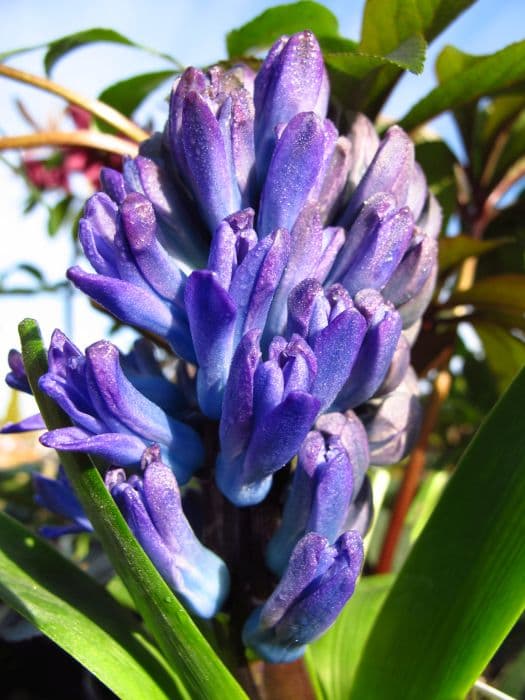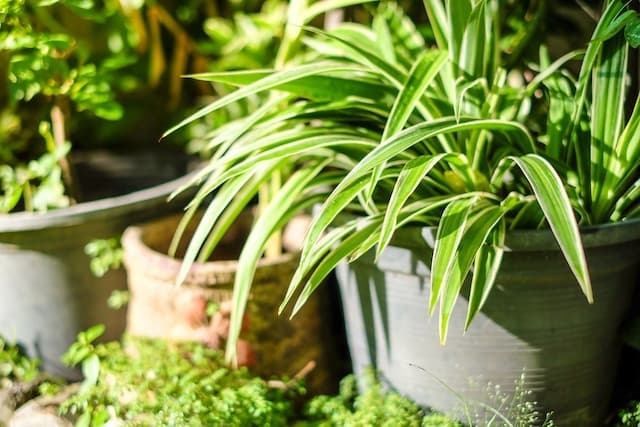Spider Plant Chlorophytum comosum 'Variegatum' (v)

ABOUT
Chlorophytum comosum 'Variegatum', commonly known as the Variegated Spider Plant, is a striking and popular houseplant known for its graceful, arching leaves and attractive variegation. The long, narrow leaves are a rich, glossy green with outer margins edged in creamy white. This two-toned effect gives the foliage a bright and refreshing appearance that adds visual interest to any indoor setting. The plant often forms a dense rosette of foliage that cascades down, making it an ideal choice for hanging baskets or elevated planters. Its leaves can give the illusion of a flowing green and white fountain. Occasionally, the Spider Plant will produce small, white, star-shaped flowers on long, slender stems that extend beyond the main body of foliage. These stems can also give rise to small baby plants, commonly referred to as spiderettes or plantlets, that dangle from the mother plant like delicate, miniature versions of the main rosette. The combination of its variegated leaves, easy care, and charming growth habit makes the Variegated Spider Plant a beloved option for both novice and experienced plant enthusiasts looking to add a touch of greenery to their indoor spaces.
About this plant
 Names
NamesFamily
Asparagaceae
Synonyms
Spider Plant, Airplane Plant, St. Bernard's Lily, Spider Ivy, Ribbon Plant, Hen and Chickens.
Common names
Anthericum comosum, Chlorophytum capense, Chlorophytum laxum R.Br., Chlorophytum orchidastrum, Hartwegia comosa, Phalangium comosum.
 Toxicity
ToxicityTo humans
The Spider Plant, as Chlorophytum comosum 'Variegatum' is commonly known, is not toxic to humans. It is considered safe and non-poisonous, thus ingestion of this plant typically does not cause any harmful effects to humans.
To pets
The Spider Plant is also non-toxic to pets, including cats and dogs. While it is generally safe, ingestion of large quantities can sometimes lead to mild gastrointestinal irritation, primarily due to the fibrous nature of the plant matter, but overall, it does not cause significant harm or poisoning to pets.
 Characteristics
CharacteristicsLife cycle
Perennials
Foliage type
Evergreen
Color of leaves
Variegated
Flower color
White
Height
1-2 feet (30-60 cm)
Spread
1-2 feet (30-60 cm)
Plant type
Herb
Hardiness zones
9
Native area
Africa
Benefits
 General Benefits
General Benefits- Easy to care for: The Spider Plant (v) is known for being hardy and low maintenance, making it ideal for beginners or busy individuals.
- Adaptable: It can thrive in a variety of light conditions, from bright, indirect light to partial shade.
- Pet-friendly: The Spider Plant (v) is non-toxic to cats and dogs, which makes it a great addition to pet owners' homes.
- Aesthetic appeal: Its variegated leaves add a touch of greenery and enhance the visual interest of indoor spaces.
- Humidity tolerance: The plant can tolerate and thrive in different levels of humidity, suitable for various indoor environments.
- Propagation ease: Spider Plants (v) are easy to propagate, allowing for more plants to be cultivated from offshoots or "spiderettes."
 Medical Properties
Medical PropertiesThis plant is not used for medical purposes.
 Air-purifying Qualities
Air-purifying QualitiesThis plant is not specifically known for air purifying qualities.
 Other Uses
Other Uses- Edible Decoration: The young shoots of Spider Plant can be used as garnishes for salads and cold dishes, though they are not commonly consumed.
- Natural Pest Repellent: Spider Plant is believed to repel certain pests, making it a companion plant to keep nearby vulnerable plants.
- Aquarium Plant: It can be used in aquariums as part of the aquascaping, providing a natural environment for fish whilst not being truly aquatic.
- Children's Craft Projects: Its quick growth and ease of propagation can be educational and engaging for children learning about plant development.
- Education and Research: Spider Plant is often used in academic settings to study phytoremediation and other botanical processes.
- Plant Breeding Programs: Due to its variegated leaves, it is used to develop new ornamental plant varieties through breeding experiments.
- Fiber Source: Though not commonly utilized, the strong, long leaves of the Spider Plant have potential for making natural fibers for crafts.
- Green Roofing: Spider Plant can contribute to green roofs, providing coverage and aiding in building temperature regulation.
- Photography Prop: Its distinct appearance makes the Spider Plant a popular choice for photographers looking for greenery in their compositions.
- Stress Reduction: Caring for a Spider Plant can offer therapeutic benefits and reduce stress through the act of nurturing a living organism.
Interesting Facts
 Feng Shui
Feng ShuiThe Spider Plant, or Chlorophytum comosum 'Variegatum', is considered good for Feng Shui as it is believed to purify the air and improve indoor air quality, thus fostering a sense of well-being and calm. In Feng Shui, it is often placed in areas with high traffic to cleanse negativity and should be placed in the wealth areas of your home or workplace to promote prosperity and good fortune.
 Zodiac Sign Compitability
Zodiac Sign CompitabilityThe Spider Plant is not used in astrology practice.
 Plant Symbolism
Plant Symbolism- Purity: The Chlorophytum comosum 'Variegatum', commonly known as Spider Plant, is often associated with the idea of purity because of its air-purifying qualities, as it can remove toxins from indoor environments.
- Resilience: Spider Plants are hardy and adaptable, symbolizing the ability to thrive in various conditions and representing resilience in the face of adversity.
- Protection: This plant is believed to possess protective qualities, guarding against negative influences and promoting a safe, peaceful home environment.
- Health and Wellness: Given its air-cleaning properties, the Spider Plant is symbolic of good health and wellness, as it contributes to a cleaner and healthier living space.
 Water
WaterThe Spider Plant benefits from even moisture but allows the top inch of soil to dry out between waterings. Water thoroughly when you do, ensuring excess water drains out of the bottom of the pot; this should be about once a week, but frequency can vary depending on the environment. A rough guide is to water with about two cups of water, or approximately 16 ounces, for a medium-sized pot every 7 days during the growing season. In the winter, watering can be reduced to when the soil feels dry to the touch—possibly every 10 days to 2 weeks. Always check the soil moisture level before watering to avoid overwatering, which can lead to root rot.
 Light
LightThe Spider Plant prefers bright, indirect light but can tolerate some shade. Avoid direct sunlight as it can scorch the variegated leaves of the plant. A spot near an east-facing window with some sheer curtains to diffuse the bright morning sun is ideal for these conditions.
 Temperature
TemperatureSpider Plants thrive in temperatures between 65-75°F, which are common in most indoor environments. They can survive in temperatures as low as 50°F and as high as 90°F but should be protected from sudden temperature drops and frost. The ideal range for vigorous growth is within the standard room temperature spectrum.
 Pruning
PruningPruning is essential for the Spider Plant to remove brown or damaged leaves and to encourage bushier growth. Trim off such leaves at the base using clean, sharp scissors or shears. The best time for pruning is in the spring or early summer, which can be done every 2 to 3 months, or as needed when you notice dead or damaged foliage.
 Cleaning
CleaningAs needed
 Soil
SoilSpider Plant prefers well-draining soil with a mix of potting soil, peat, and perlite or sand. Aim for a soil pH between 6.0 and 7.2 for optimal growth.
 Repotting
RepottingSpider Plants should be repotted every 1-2 years or when they become root-bound to encourage continued growth and health.
 Humidity & Misting
Humidity & MistingSpider Plants thrive best in average household humidity levels between 40-60% but are quite adaptable to varying conditions.
 Suitable locations
Suitable locationsIndoor
Place in bright, indirect light and water moderately.
Outdoor
Part shade to full sun; protect from extreme heat.
Hardiness zone
9-11 USDA
 Life cycle
Life cycleThe Spider Plant (Chlorophytum comosum 'Variegatum') starts its life cycle as a seed or through vegetative reproduction when small plantlets formed on the mother plant's stolons take root. Upon germination or rooting, it enters a phase of rapid vegetative growth, producing long, slender leaves with white variegation and developing a strong root system. As the plant matures, it starts to form runners or stolons, which extend outward and eventually produce small white flowers. After flowering, these stolons often give rise to tiny plantlets at their tips, which can easily root to form new spider plants when they come in contact with soil. Throughout its life, the Spider Plant requires periods of growth and rest, typically growing more actively in the warmer months and slowing down during cooler, dormant periods. Spider Plants can live for many years, and with optimal conditions, they can continue to produce new plantlets, spreading and propagating themselves within their environment.
 Propogation
PropogationPropogation time
Spring-Summer
The Chlorophytum comosum 'Variegatum', commonly known as the variegated spider plant, is best propagated during the spring and summer months when the plant's growth is most active. The most popular method of propagation is by using the plantlets or spiderettes that form readily on long stolons or runners. To propagate, wait until the spiderettes develop small roots, then cut them from the mother plant. You can either plant them directly into soil or initially root them in water. If rooting in water, submerge only the roots and avoid the leaves touching the liquid; once substantial roots form, usually within a couple of weeks, transfer to a pot with all-purpose potting soil. It is important to keep the soil moist but not waterlogged to promote healthy root growth.









